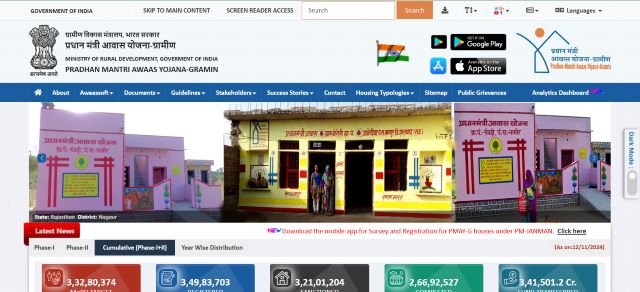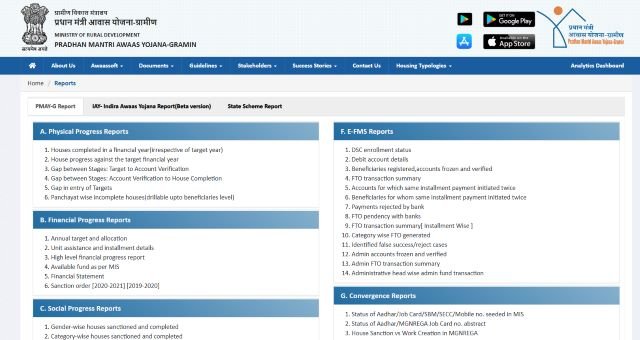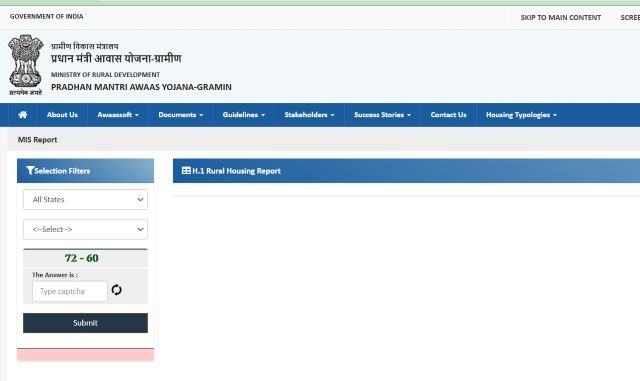The PMAY-G list displays beneficiaries selected for the Pradhan Mantri Awaas Yojana Gramin (PMAY-G), a rural housing scheme by the Indian government. This initiative aims to provide affordable housing to the economically weaker sections in rural areas. Beneficiaries are identified based on data from the Socio-Economic and Caste Census (SECC) 2011, ensuring that only eligible families are selected. The list provides information such as the beneficiary’s name, allotted funds, and progress status of house construction.

By visiting the official website, users can check eligibility and access the list using a state, district, or block-wise filter. The transparency offered by this platform helps beneficiaries stay informed and monitor the progress of housing assistance under the PMAY-G program.
What is PM Awas Yojana Gramin?
The Pradhan Mantri Awas Yojana Gramin (PMAY-G) is a government initiative focused on providing affordable pucca (permanent) houses with basic amenities to rural families living in kutcha (temporary) homes or without housing by 2024. Beneficiaries are identified using data from the Socio-Economic Caste Census (SECC) 2011, prioritizing houseless families, those in one or two-room kutcha houses, and households with higher housing deprivation. The scheme emphasizes inclusivity, giving priority to vulnerable groups such as Scheduled Castes (SC), Scheduled Tribes (ST), minorities, and female-headed households, as well as those with persons with disabilities.
To support construction, beneficiaries receive financial assistance of Rs. 1.20 lakh in plains and Rs. 1.30 lakh in hilly regions, with additional access to loans up to Rs. 70,000 if needed. Payments are made through Direct Benefit Transfer (DBT) in installments tied to construction progress, ensuring timely funds and transparency. PMAY-G also promotes gender equity by mandating house ownership in the name of the female head or jointly in the husband’s and wife’s names.
Important Factors
| Name of the Scheme | Pradhan Mantri Awas Yojana Gramin (PMAY-G) |
| Launched By | Government of India |
| Objective | Provides affordable pucca houses to rural houseless families and those in kutcha homes by 2024 |
| Beneficiary Selection | Uses SECC 2011 data, verified by the Gram Sabha for fair beneficiary selection |
| Prioritization | Priority to houseless and kutcha-house residents, with focus on SC, ST, minorities, and female-led families |
| Special Provisions | Additional support for disabled, widowed, elderly, and female-headed households |
| Financial Assistance | Rs. 1.20 lakh for plains, Rs. 1.30 lakh for hilly areas, disbursed in DBT-linked installments |
| Loan Facility | Optional loans up to Rs. 70,000 through SLBC & DLBC for construction assistance |
| Ownership Requirement | Houses sanctioned in female head’s name or jointly with spouse, promoting gender equity |
| Technical Support | Provides technical guidance to beneficiaries for quality construction |
| Transparency Mechanism | Real-time tracking of beneficiaries and construction progress for accountability |
| Official Website | https://pmaymis.gov.in/ |
About www.pmayg.nic.in Portal
The www.pmayg.nic.in portal is the official website for the PM Awaas Yojana Gramin (PMAY-G), a government initiative to provide affordable housing for rural families. This portal enables beneficiaries and citizens to access vital information about the scheme, check eligibility, and view the beneficiary list based on SECC 2011 data. Users can track application status, construction progress, and funds released through a state, district, or block-wise filter. The portal also offers resources like policy guidelines, official notifications, and detailed updates to ensure transparency. Additionally, beneficiaries can log in to view personal records and installment details, making the platform a comprehensive tool for monitoring PMAY-G activities.
The objective of PM Awas Yojana Gramin
The objectives of Pradhan Mantri Awas Yojana Gramin are as follows:
- The objective of the scheme is to provide affordable, permanent (pucca) houses to rural families.
- The aim of the scheme is to replace kutcha (temporary) houses with pucca houses to improve living conditions.
- The scheme aims to ensure housing for all rural houseless families by 2024.
- The target is to focus on vulnerable groups like Scheduled Castes (SC), Scheduled Tribes (ST), minorities, and female-led households.
- The scheme aims to promote gender equity by encouraging female ownership of homes.
Eligibility Criteria
To avail the benefits under the scheme, you should fulfill the following requirements, which are as follows:
- Families without housing or living in kutcha houses with non-durable materials.
- Beneficiaries identified based on the Socio-Economic and Caste Census (SECC) 2011.
- Priority given to Scheduled Castes (SC), Scheduled Tribes (ST), minorities, and female-headed households.
- Families with no able-bodied adults, widows, or disabled members get automatic priority.
- Eligibility is confirmed through the village council (Gram Sabha) to ensure fairness and transparency.
- Generally applies to economically weaker sections in rural areas.
- 5% of houses reserved for households with persons with disabilities.
Salient Features
The salient features of Pradhan Mantri Awas Yojana – Gramin (PMAY-G) are as follows:
- Provides pucca (permanent) houses for rural houseless families and those in kutcha houses.
- Offers Rs. 1.20 lakh for plains and Rs. 1.30 lakh for hilly areas, disbursed in installments.
- Funds are transferred directly into beneficiaries’ bank accounts to ensure transparency.
- Beneficiaries can access loans up to Rs. 70,000 for construction support.
- Houses are registered in the female head’s name or jointly with the husband to promote gender equality.
- Priority is given to SC, ST, minorities, female-led households, and persons with disabilities.
- Guidance is provided to ensure quality construction.
- Real-time tracking of beneficiary status and construction progress through the official portal.
Search www.pmayg.nic.in List Online
To search the www.pmayg.nic.in list online, follow the steps given below:
Step 1: Visit the PMAYG Website.

Step 2: Select “Awaassoft” from the main menu.
Step 3: From the dropdown, click on the “Report” option.

Step 4: You’ll be redirected to the rhReporting.nic.in portal.
Step 5: Under “Social Audit Reports”, click on “Beneficiary details for verification”.

Step 6: On the MIS Report page, fill in required fields such as state, district, block, and village.
Step 7: Click on the “Submit” button to view or check the beneficiary list.
State Wise www.pmayg.nic.in List
| State/UT | State/UT |
| Andhra Pradesh | Odisha |
| Arunachal Pradesh | Punjab |
| Assam | Rajasthan |
| Bihar | Sikkim |
| Chhattisgarh | Tamil Nadu |
| Goa | Telangana |
| Gujarat | Tripura |
| Haryana | Uttar Pradesh |
| Himachal Pradesh | Uttrakhand |
| Jharkhand | West Bengal |
| Karnataka | Andaman & Nicobar |
| Kerala | Chandigarh |
| Madhya Pradesh | Dadra & Nagar Haveli and Daman & Diu |
| Maharashtra | Delhi |
| Manipur | Jammu & Kashmir |
| Meghalaya | Ladakh |
| Mizoram | Lakshadweep |
| Nagaland | Puducherry |
Helpline Number
- Email ID: support-pmayg[at]gov[dot]in
FAQs
What is PMAY-G?
PMAY-G is a government initiative to provide affordable, permanent housing to rural families living in kutcha houses or without housing.
Who is eligible for PMAY-G?
Families identified in the SECC 2011 data as houseless or living in kutcha houses. Priority is given to SC, ST, minorities, female-headed households, and vulnerable groups.
How can I check my name in the beneficiary list?
Visit the official website, go to the “Awaassoft” section, and select “Report” to view the beneficiary details.
What financial assistance is provided?
Rs. 1.20 lakh in plains and Rs. 1.30 lakh in hilly areas, disbursed in installments based on construction progress.
Is there any loan facility available?
Yes, beneficiaries can avail of a loan up to Rs. 70,000 to supplement the construction of their homes.
How are funds transferred?
Funds are transferred directly to the beneficiary’s bank accounts through Direct Benefit Transfer (DBT) to ensure transparency.
Is there any support for women under PMAY-G?
Yes, houses are typically sanctioned in the name of the female head of the household or jointly with the husband, promoting gender equity.
